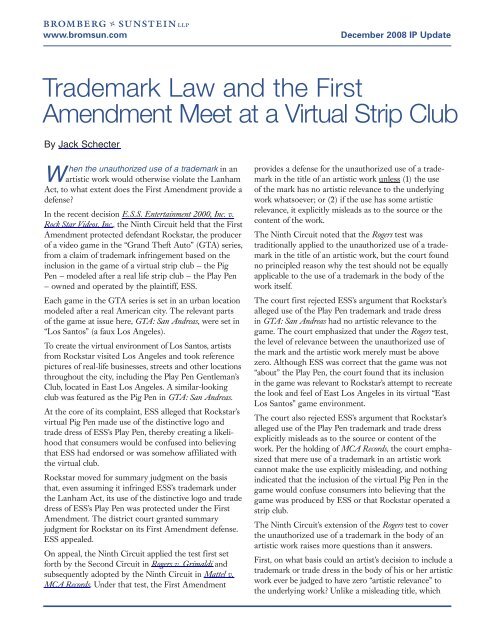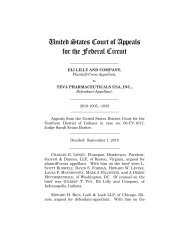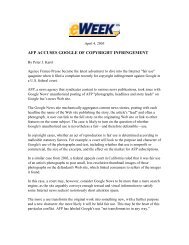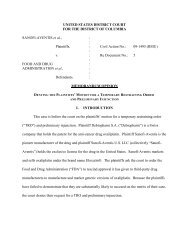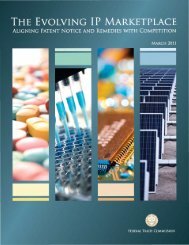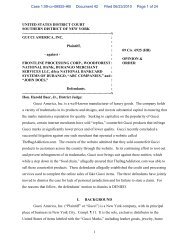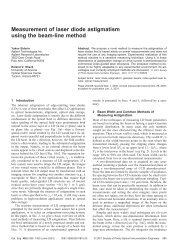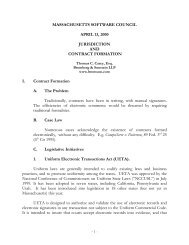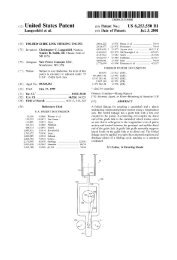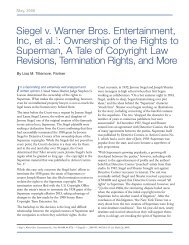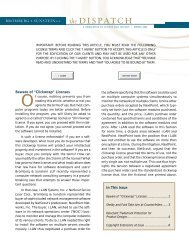Trademark Law and the First Amendment Meet at a Virtual Strip Club
Trademark Law and the First Amendment Meet at a Virtual Strip Club
Trademark Law and the First Amendment Meet at a Virtual Strip Club
You also want an ePaper? Increase the reach of your titles
YUMPU automatically turns print PDFs into web optimized ePapers that Google loves.
www.bromsun.com December 2008 IP Upd<strong>at</strong>e<br />
<strong>Trademark</strong> <strong>Law</strong> <strong>and</strong> <strong>the</strong> <strong>First</strong><br />
<strong>Amendment</strong> <strong>Meet</strong> <strong>at</strong> a <strong>Virtual</strong> <strong>Strip</strong> <strong>Club</strong><br />
By Jack Schecter<br />
W<br />
hen <strong>the</strong> unauthorized use of a trademark in an<br />
artistic work would o<strong>the</strong>rwise viol<strong>at</strong>e <strong>the</strong> Lanham<br />
Act, to wh<strong>at</strong> extent does <strong>the</strong> <strong>First</strong> <strong>Amendment</strong> provide a<br />
defense?<br />
In <strong>the</strong> recent decision E.S.S. Entertainment 2000, Inc. v.<br />
Rock Star Videos, Inc., <strong>the</strong> Ninth Circuit held th<strong>at</strong> <strong>the</strong> <strong>First</strong><br />
<strong>Amendment</strong> protected defendant Rockstar, <strong>the</strong> producer<br />
of a video game in <strong>the</strong> “Gr<strong>and</strong> Theft Auto” (GTA) series,<br />
from a claim of trademark infringement based on <strong>the</strong><br />
inclusion in <strong>the</strong> game of a virtual strip club — <strong>the</strong> Pig<br />
Pen — modeled after a real life strip club — <strong>the</strong> Play Pen<br />
— owned <strong>and</strong> oper<strong>at</strong>ed by <strong>the</strong> plaintiff, ESS.<br />
Each game in <strong>the</strong> GTA series is set in an urban loc<strong>at</strong>ion<br />
modeled after a real American city. The relevant parts<br />
of <strong>the</strong> game <strong>at</strong> issue here, GTA: San Andreas, were set in<br />
“Los Santos” (a faux Los Angeles).<br />
To cre<strong>at</strong>e <strong>the</strong> virtual environment of Los Santos, artists<br />
from Rockstar visited Los Angeles <strong>and</strong> took reference<br />
pictures of real-life businesses, streets <strong>and</strong> o<strong>the</strong>r loc<strong>at</strong>ions<br />
throughout <strong>the</strong> city, including <strong>the</strong> Play Pen Gentleman’s<br />
<strong>Club</strong>, loc<strong>at</strong>ed in East Los Angeles. A similar-looking<br />
club was fe<strong>at</strong>ured as <strong>the</strong> Pig Pen in GTA: San Andreas.<br />
At <strong>the</strong> core of its complaint, ESS alleged th<strong>at</strong> Rockstar’s<br />
virtual Pig Pen made use of <strong>the</strong> distinctive logo <strong>and</strong><br />
trade dress of ESS’s Play Pen, <strong>the</strong>reby cre<strong>at</strong>ing a likelihood<br />
th<strong>at</strong> consumers would be confused into believing<br />
th<strong>at</strong> ESS had endorsed or was somehow affili<strong>at</strong>ed with<br />
<strong>the</strong> virtual club.<br />
Rockstar moved for summary judgment on <strong>the</strong> basis<br />
th<strong>at</strong>, even assuming it infringed ESS’s trademark under<br />
<strong>the</strong> Lanham Act, its use of <strong>the</strong> distinctive logo <strong>and</strong> trade<br />
dress of ESS’s Play Pen was protected under <strong>the</strong> <strong>First</strong><br />
<strong>Amendment</strong>. The district court granted summary<br />
judgment for Rockstar on its <strong>First</strong> <strong>Amendment</strong> defense.<br />
ESS appealed.<br />
On appeal, <strong>the</strong> Ninth Circuit applied <strong>the</strong> test first set<br />
forth by <strong>the</strong> Second Circuit in Rogers v. Grimaldi <strong>and</strong><br />
subsequently adopted by <strong>the</strong> Ninth Circuit in M<strong>at</strong>tel v.<br />
MCA Records. Under th<strong>at</strong> test, <strong>the</strong> <strong>First</strong> <strong>Amendment</strong><br />
provides a defense for <strong>the</strong> unauthorized use of a trademark<br />
in <strong>the</strong> title of an artistic work unless (1) <strong>the</strong> use<br />
of <strong>the</strong> mark has no artistic relevance to <strong>the</strong> underlying<br />
work wh<strong>at</strong>soever; or (2) if <strong>the</strong> use has some artistic<br />
relevance, it explicitly misleads as to <strong>the</strong> source or <strong>the</strong><br />
content of <strong>the</strong> work.<br />
The Ninth Circuit noted th<strong>at</strong> <strong>the</strong> Rogers test was<br />
traditionally applied to <strong>the</strong> unauthorized use of a trademark<br />
in <strong>the</strong> title of an artistic work, but <strong>the</strong> court found<br />
no principled reason why <strong>the</strong> test should not be equally<br />
applicable to <strong>the</strong> use of a trademark in <strong>the</strong> body of <strong>the</strong><br />
work itself.<br />
The court first rejected ESS’s argument th<strong>at</strong> Rockstar’s<br />
alleged use of <strong>the</strong> Play Pen trademark <strong>and</strong> trade dress<br />
in GTA: San Andreas had no artistic relevance to <strong>the</strong><br />
game. The court emphasized th<strong>at</strong> under <strong>the</strong> Rogers test,<br />
<strong>the</strong> level of relevance between <strong>the</strong> unauthorized use of<br />
<strong>the</strong> mark <strong>and</strong> <strong>the</strong> artistic work merely must be above<br />
zero. Although ESS was correct th<strong>at</strong> <strong>the</strong> game was not<br />
“about” <strong>the</strong> Play Pen, <strong>the</strong> court found th<strong>at</strong> its inclusion<br />
in <strong>the</strong> game was relevant to Rockstar’s <strong>at</strong>tempt to recre<strong>at</strong>e<br />
<strong>the</strong> look <strong>and</strong> feel of East Los Angeles in its virtual “East<br />
Los Santos” game environment.<br />
The court also rejected ESS’s argument th<strong>at</strong> Rockstar’s<br />
alleged use of <strong>the</strong> Play Pen trademark <strong>and</strong> trade dress<br />
explicitly misleads as to <strong>the</strong> source or content of <strong>the</strong><br />
work. Per <strong>the</strong> holding of MCA Records, <strong>the</strong> court emphasized<br />
th<strong>at</strong> mere use of a trademark in an artistic work<br />
cannot make <strong>the</strong> use explicitly misleading, <strong>and</strong> nothing<br />
indic<strong>at</strong>ed th<strong>at</strong> <strong>the</strong> inclusion of <strong>the</strong> virtual Pig Pen in <strong>the</strong><br />
game would confuse consumers into believing th<strong>at</strong> <strong>the</strong><br />
game was produced by ESS or th<strong>at</strong> Rockstar oper<strong>at</strong>ed a<br />
strip club.<br />
The Ninth Circuit’s extension of <strong>the</strong> Rogers test to cover<br />
<strong>the</strong> unauthorized use of a trademark in <strong>the</strong> body of an<br />
artistic work raises more questions than it answers.<br />
<strong>First</strong>, on wh<strong>at</strong> basis could an artist’s decision to include a<br />
trademark or trade dress in <strong>the</strong> body of his or her artistic<br />
work ever be judged to have zero “artistic relevance” to<br />
<strong>the</strong> underlying work? Unlike a misleading title, which
www.bromsun.com December 2008 IP Upd<strong>at</strong>e<br />
might be considered separ<strong>at</strong>e <strong>and</strong> apart from <strong>the</strong> underlying<br />
work, it is difficult to conceive of a trademark<br />
being used in <strong>the</strong> body of a work of art itself but having<br />
no artistic relevance to <strong>the</strong> work wh<strong>at</strong>soever.<br />
Once a mark is used in a work of art, <strong>the</strong> mark is a part<br />
of <strong>the</strong> work <strong>and</strong> should, by definition, be considered to<br />
have some relevance to <strong>the</strong> work. Where artistic works<br />
are concerned, <strong>the</strong> court appears to have set up a test no<br />
unauthorized trademark use could fail to pass.<br />
Second, with respect to <strong>the</strong> “explicitly misleading”<br />
prong of <strong>the</strong> Rogers test, <strong>the</strong> court made clear th<strong>at</strong> an<br />
unauthorized use itself cannot qualify as explicitly<br />
misleading. However, it went on to muddy <strong>the</strong> w<strong>at</strong>ers<br />
significantly by applying, in essence, a likelihood-ofconfusion<br />
analysis in determining whe<strong>the</strong>r Rockstar’s<br />
alleged use of <strong>the</strong> Play Pen trade dress was “explicitly<br />
misleading.”<br />
The court’s applic<strong>at</strong>ion of <strong>the</strong> likelihood-of-confusion<br />
test in this context is puzzling given th<strong>at</strong> (1) <strong>the</strong> <strong>First</strong><br />
<strong>Amendment</strong> defense under consider<strong>at</strong>ion is an affirm<strong>at</strong>ive<br />
defense th<strong>at</strong> already presumes some degree of consumer<br />
confusion viol<strong>at</strong>ive of <strong>the</strong> Lanham Act <strong>and</strong> (2) a likelihood-of-confusion<br />
is a threshold far lower than <strong>the</strong><br />
st<strong>at</strong>ed “explicitly misleading” requirement.<br />
With <strong>the</strong> frequent pop-cultural cross-referencing <strong>and</strong><br />
ubiquitous product placement taking place throughout<br />
television, music <strong>and</strong> film — not to mention <strong>the</strong> burgeoning<br />
video game industry — courts <strong>and</strong> practitioners will<br />
soon be forced to confront <strong>the</strong> doctrinal questions left<br />
unanswered by <strong>the</strong> ESS decision.<br />
125 Summer Street, Boston, MA 02110-1618 Telephone: (617) 443-9292 www.bromsun.com<br />
© 2008 Bromberg & Sunstein LLP


